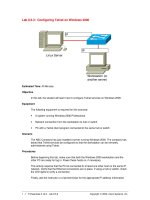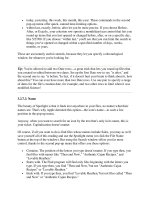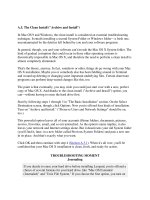THE Stop Walking on Eggshells WORKBOOK pdf
Bạn đang xem bản rút gọn của tài liệu. Xem và tải ngay bản đầy đủ của tài liệu tại đây (1.52 MB, 223 trang )
“Kreger
gives an incredible amount of information, yet meets the needs of
many types of readers. The anecdotes are memorable, the tasks are engaging,
and the structure allows people to read it on an intellectual or emotional level.
Most importantly, she has provided a great bridge between the high-level,
abstract BPD theories and research and the realities of everyday life.”
—Patricia Davis, family member of a person with BPD
“The workbook is absolutely extraordinary. It’s a masterpiece and one of a
kind. I couldn’t put it down. The Action Steps are right on target. Like Stop
Walking on Eggshells, this book is another work of art.”
—Rita Closson, M.A.THE
Stop Walking
on Eg
gshells
WORKBOOK
P
ractical Strategies
for Living with
Someone Who Has
Borderline
Personality Disorder
New Harbinger P
ublications, Inc.
RAN
DI
KRE
GER
w
i t h
j
a m e s
p
a u l
s
h i r l e y
,
l
.
m
.
s
.
w
.
Publisher
’s Note
This
publication is designed to provide accurate and authoritative information in regard to the subject matter covered. It is sold with the
understanding that the publisher is not engaged in rendering psychological, financial, legal, or other professional services. If expert
assistance or counseling is needed, the services of a competent professional should be sought.
Distributed in Canada by Raincoast Books
Lyrics from “This Too Will Pass” written by Carrie Newcomer. Published by CARRIE NEWCOMER MUSIC/Administered
by BUG. All rights reserved. Used by permission.
Quotes from I’m Not Supposed to Be Here by Rachel Reiland are reprinted with her permission. Published by Eggshells Press,
2002.
Quotes and recommendations from Teresa Whitehurst are printed with her permission.
Quotes from Helen S. are printed with her permission.
Quotes from Shannon Mike are printed with her permission.
Quotes from “Non-guy” are used with his permission.
Copyright © 2002 by Randi Kreger
New Harbinger Publications, Inc.
5674 Shattuck Avenue
Oakland, CA 94609
Cover design by Amy Shoup
Edited by Brady Kahn
Text design by Tracy Powell-Carlson
Paperback:
ISBN-10 1-57224-271-X
ISBN-13 978-1-57224-271-0
Ebook:
ISBN-13: 978-1-57224-715-4
All Rights Reserved
Printed in the United States of America
New Harbinger Publications’ website address: www.newharbinger.com
10 09 08
20 19 18 17 16 15 14 13 12
This
book is dedicated to my husband, Robert L. Burko, a man who says he does not believe
in unconditional love but gives it nevertheless. His love, acceptance, and willingness to
support me and my BPD work over these past years have made this workbook possible and
enriched the lives of thousands of people he will never know. Thank you.
tight, hold hands with me
All is trouble just as far as you can see
So here we are and here we stand
So we’ll stare it down just to prove that we can
And ride it out to the last
It’s true, this too will pass.
Small comfort when it goes so deep
And you roll at night in fitful sleep
I’ll tell you what I know
As sure as trouble comes
Yah, trouble will go
I’ll say it though you didn’t ask
It’s true, this too will pass.
So lay it down, lay it down right here.
All your sorrows, all your troubles and your fears.
I can’t tell you how it goes this far
Or explain why it gets so damn hard
Or there are times that shine like jewels
And will be all the brighter for what you’ve been through
So hold these times tightly clasped
It’s true, this too will pass.
So out of the darkest place
And the hardest times that you’ve ever had to face
We’re more tender than some would believe
And we still find it hard to ask for what we need
But don’t give up too fast
It’s true, this too will pass
It’s true, this too will pass.
—Carrie Newcomer, “This Too Will Pass”
Contents
Foreword ix
Acknowledgments xi
Introduction 1
Part
1
From Confusion to Clarity: Understanding BPD
Chapter
1
Walking on Eggshells: Does Someone in Your Life Have BPD Traits? 9
Chapter 2
Defining BPD: The DSM-IV and Cognitive Distortions 27
Chapter 3
Defining BPD: The Subtypes 41
Chapter 4
Getting Together: Relationship Behavior Patterns 55
Chapter 5
Brainwashing 101: How BPD Behavior Affects You 71
Chapter
6
Beyond Denial: Accepting What You Cannot Change
(And Changing What You Can)
91
Chapter 7
Treasuring Yourself: Owning Your Own Reality 107
Chapter 8
Clearing the FOG: Fear, Obligation, and Guilt 129
Chapter 9
Being Heard: Communicating with a Borderline 139
Part
2
Making Wise Decisions and Implementing Them
Chapter
10
Considering Options and Making Decisions 157
Chapter 11
Finding Qualified Professional Help 175
Appendix A
Reading List and Resources 181
Appendix B
Glossary 189
Appendix C
Safety Plan for Domestic Violence Situations 197
References 199
Index 203
viii The Stop Walking on Eggshells Workbook
Foreword
I
n addition to directly helping friends and family members of people with Border-
line Personality Disorder (BPD), this workbook offers mental health professionals
a hopeful new approach for their clients who are in relationships with borderlines.
Just as Al-Anon can be the practitioner’s best friend in dealing with clients affected
indirectly by alcoholism, Stop Walking on Eggshells (Mason and Kreger 1998) and
this companion workbook, along with online support groups, can be the beginning
of a community of support for people affected indirectly by BPD.
Today, BPD treatment has many of the same problems that faced addictions
treatment in the early 1970s. At that time society tended to view addiction as a fail-
ure of personal morality as well as a deeply shameful personal problem. While
most mental health practitioners were not quite so moralistic, many were still pes-
simistic about addiction and considered it difficult to treat at best. Two practices
changed these attitudes. First, clinicians became more willing to work with
self-help groups as allies in the treatment process. Secondly, they began including
family members as an integral part of the treatment process. Consequently,
improvements began to occur as those in the field began to recognize the indirect
effects of addiction—i.e., codependence—as a separate interpersonal component
that helps feed the cycle of addiction and needs separate clinical attention.
The same principles that worked with addiction are now proving to work
where BPD is concerned. The commonsense simplicity of Kreger’s interpersonal
approach works, where the older, more limited intra-psychic individual
approaches have often failed. In my role as a therapeutic consultant on Kreger’s
Internet family of support groups called “Welcome to Oz,” I have seen people get
results when they apply the principles contained in this workbook. I have heard
people who are trying hard to cope with friends, partners, or family members with
BPD
repeatedly insist that these online support groups—supplemented with infor-
mation in Stop Walking on Eggshells (SWOE), Kreger’s earlier book—have helped
them more quickly and effectively than counseling did. (Research conducted by
Kreger and statistics professor Edith Cracchiolo [Cracchiolo and Kreger 1997]
showed that 75 percent of the [then 250] members of Welcome to Oz had sought
professional help for their problems dealing with their significant others.)
Increasingly, I am now hearing online support group participants say they
wish their therapists had had the information in SWOE, or wish that their thera-
pists had referred them to Kreger’s Web site and Welcome to Oz support groups.
The combination of pertinent information, together with interpersonal support, is
working.
The goal of this workbook is to re-create some of the helpful experiences of
reading SWOE and participating in an online support group. Using realistic sce-
narios based on compilations of real-life experiences, Kreger and I take the reader
through a series of Action Steps designed to build knowledge and confidence in
applying the principles described in SWOE. The result is not an academic descrip-
tion of Borderline Personality Disorder, but rather a guide to help you cope with
the problem behavior BPD causes.
Hopefully, the long-term result of our work will be a growing community of
people who speak a common language, who know some techniques for dealing
with BPD, and who understand how to apply those techniques in real-life situa-
tions. If this workbook helps just one person take back control of his or her life,
then we will have succeeded.
—James Paul Shirley, M.S.W.
x The Stop Walking on Eggshells Workbook
Acknowledgments
A
lthough I am listed as the “author” of this workbook, there is no shortage of peo-
ple whose contributions made this work possible. First, a heartfelt thanks to the
primary contributors to this workbook, including James Paul Shirley, M.S.W., who
reviewed the book and wrote many of the Action Steps, and editor and writer
Wynne Brown, who was instrumental in editing the draft and writing certain sec-
tions about borderline offspring. Additional contributors include Rachel Reiland,
author of I’m Not Supposed to Be Here: My Recovery from Borderline Personality Disor-
der (2002); Kathy Winkler, my coauthor of Hope for Parents: Helping Your Borderline
Son or Daughter without Sacrificing Your Family or Yourself (Winkler and Kreger
2000); and Kim Williams-Justesen, my coauthor of Love and Loathing: Protecting
Your Mental Health and Legal Rights When Your Partner Has Borderline Personality
Disorder (Kreger and Williams-Justesen 1999). Thank you all.
In cyberspace, a thank-you to all those who created and participated in our
Welcome to Oz (WTO) Internet community of friends and family members of
those with Borderline Personality Disorder. The feedback from WTO members
was invaluable in making this publication as effective as possible. I am also grate-
ful for the continuing guidance and assistance of Rita Closson, M.A., social psy-
chologist and list patrol chief, as well as Edith, James, Eric, and Deborah. This
workbook reflects the accomplishments of all the WTO facilitators and their
friends, past and present, who have consistently reminded me that the destructive-
ness of borderline behavior can be tempered or even eliminated by using the tech-
niques in Stop Walking on Eggshells and this workbook.
In the “real” world, special thanks to those who made this workbook possible:
my Stop Walking on Eggshells coauthor Paul Mason, M.S., my husband Robert
Burko, my guardian angel Edith Cracchiolo, and all the staff at New
Harbinger—especially
Patrick Fanning (my mentor through this project). From the
owners to the people who work in customer service, everyone has been enthusias-
tic, supportive, and flexible. Their decisions to print Stop Walking on Eggshells and
this workbook have helped thousands of people reclaim their lives.
Keeping up with orders for Stop Walking on Eggshells and the booklets I pub-
lish is a sensitive, crucially important job. Merci beaucoup to Alan, Mary Jane, and
the staff at PIP Printing for keeping the booklets quickly flowing even when
checks get backlogged, and Nancy, Diane, and all the staff at Book Clearing House
in New York for their high-caliber service and compassion to callers.
Mental health writers whose work especially inspired me include Jan Black
and Greg Enns and their incredible book Better Boundaries: Owning and Treasuring
Your Own Life (1997); self-help author Beverly Engel, primarily for her book Loving
Him without Losing You (2000); Christine Ann Lawson, Understanding the Borderline
Mother: Helping Her Children Transcend the Intense, Unpredictable, and Volatile Rela-
tionship (2000); and Susan Forward and Donna Frazier, especially their book Emo-
tional Blackmail: When the People in Your Life Use Fear, Obligation and Guilt to
Manipulate You (1997).
In addition to James Paul Shirley and Paul Mason, clinicians who graciously
gave me their time for an interview for this workbook include George Smith,
L.I.C.S.W., associate director of outpatient personality disorders service at McLean
Hospital; and Teresa Whitehurst, Ph.D., clinical instructor at Harvard Medical
School and director of the Cambridge Family Language Project.
Finally, thanks for the encouragement and validation of Mary, J.T., and a few
others who kept reminding me that this work is important and that I need to keep
going, no matter what. You all sustain me and make it all possible.
xii The Stop Walking on Eggshells Workbook
Introduction
I
never
set out to dedicate more than five years to researching and writing about
how the behavior of those with Borderline Personality Disorder (BPD) affects
family members. You don’t choose some jobs, they choose you. Or as singer/song-
writer Carrie Newcomer puts it in “Close Your Eyes,” “How I got this job I’ll
never know, but when it calls, you can’t refuse to go.”
My involvement with BPD began as a personal quest. In the early 1990s, I
learned that a person who had had a large influence on my life suffered from some
of the traits of BPD. Since I had never heard of this disorder, I eagerly looked for
information about how such distorted behavior affects loved ones. I discovered
that few clinicians knew the answers—or, frankly, were even looking.
I found this extraordinary. Borderline Personality Disorder by definition nega-
tively involves other people, according to the Diagnostic and Statistical Manual of
Mental Disorders (DSM-IV) (APA 1994), the standard reference for the diagnosis
and treatment of psychiatric illnesses. To others, people with BPD can appear to be
emotionally or verbally abusive, manipulative, deceitful, invalidating, demanding,
lacking in empathy, illogical, unfair, self-absorbed, and abusive to children. This is
a result of their inner pain. But the effects can still be devastating. Why wasn’t
anyone studying this?
According to the DSM-IV, BPD affects 2 percent of the population, about 6
million people in North America. But that statistic is artificially low. When I give
workshops to clinicians, about half of them say that they have learned to put the
client’s secondary diagnosis (common ones include depression, eating disorder, or
substance abuse) on the client’s chart. They do this for two reasons: one, some
insurance companies refuse to pay for treatments for personality disorders. They
consider them “incurable” despite medications and therapies that have been
shown to improve BPD symptoms. Secondly, mental health practitioners want to
protect BPD patients from the dreaded “Borderline Stigma”—its main symptom
being a scarlet “B” carved in patients’ foreheads by other practitioners who blame
them for not getting better or choose not to treat people with this diagnosis. There-
fore, I believe that 2 percent figure is a gross underestimate.
Assuming that each borderline individual (BP) affects three other people, BPD
behavior impacts 30 million people. The price is enormous: high-conflict divorce,
substance abuse, suicide, lost productivity, criminal activity, domestic violence,
hospitalization, therapist burnout, and more. The total amount of money and pro-
ductivity lost is unknown, but is probably in the millions of dollars.
But money is not my greatest concern. I do this work to help prevent abusive
borderlines who refuse treatment from being abusive to children (who are at risk
of becoming borderline themselves) and to empower partners who feel helpless to
stop emotional, verbal, and even physical abuse. Even though borderlines usually
do not intend to be abusive, their actions can be abusive. And verbal and emo-
tional abuse is just as bad as physical abuse in terms of contributing to BPD. In
other words, my mission is prevention, not treatment, of BPD.
When I realized that I couldn’t depend on the mental health profession, the
media (which mostly covers illnesses with celebrity spokespeople), or even public
or private mental health organizations to provide support and information about
2 The Stop Walking on Eggshells Workbook
the
many different ways BPD affects the sufferer and the people around them, I
decided to start an Internet support group and write a book (eventually called Stop
Walking on Eggshells) with therapist Paul Mason, M.S.
Our hope was to validate the experiences of the millions of “nonborderlines,”
or non-BPs (partners, friends, or family member of a person with BP); increase
awareness of all types of the disorder; and teach coping methods and healthier
behaviors to family members and friends who experience BPD behavior as confus-
ing, chaotic, or abusive. While Paul squeezed whatever he could out of the scien-
tific studies, I started speaking with other people related to borderlines the only
place I could find them: on the Internet and America Online.
In order to share stories, in December 1995 I started an Internet listserv sup-
port group with the technical help of a computer guru from the Netherlands. The
Welcome to Oz list (the title refers to Dorothy’s disorientation when she travels
from Kansas to Oz) has blossomed into a family of groups, totaling 2,000
members.
Paul Mason and I used these Internet discussions as a blueprint for Stop
Walking on Eggshells (SWOE), which New Harbinger published in July 1998. “The
Little Book that Could” went on to sell 45,000 copies (as of this writing) and make
Amazon.com’s “Movers and Shakers” list several times. Not bad for a specialized
book originally rejected by thirty publishers because the audience was “too nar-
row” and “no one ever heard of Borderline Personality Disorder.”
Using the tools and information in Stop Walking on Eggshells, as well as their
own insights and support gained from each other, readers and online support
group participants began to take back control of their lives—even when their dis-
ordered family member or friend refused treatment or joint-relationship problem
solving. The site and list helped spur others to develop their own sites and lists,
creating a wellspring of information on the Internet about BPD.
I went on to found my own publishing company, Eggshells Press, and pro-
duce materials that Stop Walking on Eggshells could not address in detail for lack of
space. These include Love and Loathing: Protecting Your Mental Health and Legal
Rights When Your Partner Has Borderline Personality Disorder (Kreger and
Wiliams-Justesen 1999); Hope for Parents: Helping Your Borderline Son or Daughter
without Sacrificing Your Family or Yourself (Winkler and Kreger 2000); the three-set
CD You’re My World: A Non-BP’s Guide to Custody (see appendix A); and I’m Not
Supposed to Be Here: My Recovery from Borderline Personality Disorder (Reiland 2002).
Most authors have little contact with their readers. But because of the Internet
support groups and several in-person gatherings, I was able to assess how well
non-BPs were understanding and using the principles and techniques in Stop
Walking on Eggshells (also known as SWOE). Over the years, dozens of list mem-
bers told me that SWOE was so densely packed with information that they had to
read it several times, highlighting important sections and making notes in the mar-
gins. Clearly, BP and non-BP interactions are so complex that people need assis-
tance to apply the material in SWOE to their own lives.
For example, people wanted to know, “Why did the BP in my life do this?”
”What should I have done in this situation?” and “What does this confusing
Introduction 3
behavior
mean?” BPD is a complex disorder, and intellectual knowledge doesn’t
necessarily translate into personal enlightenment. Most importantly, it takes time
and feedback for non-BPs to go through the stages of grief and the five stages of
the BP/non-BP relationships detailed in SWOE.
Thus, the idea for this workbook was born. It is not based on scientific studies;
they don’t exist. It’s not a scientific book about BPD; in fact, it’s not about BPD. It’s
about how to live with someone who has the disorder and still feel in control of
your own life. It’s based on my own experiences with BPs and non-BPs, interviews
with clinicians, and my work cofacilitating the Welcome to Oz lists for five years.
In order to show you how BPD behavior works in real life, some of the exercises,
or Action Steps, use portions of I’m Not Supposed to Be Here.
This workbook is also not a non-BP “bible” (as some people refer to SWOE)
because too many variables exist to make the work complete. People with BPD act
in a variety of ways—some 180 degrees differently—making the needs of family
members and friends extremely different as well. The concerns of non-BPs also
differ according to the type of relationship between BP and non-BP. Therefore,
rather than try to make this workbook everything to everyone, I’ve decided to
keep things as simple and universal as possible. For more specific information,
you may wish to read SWOE and the material listed in the bibliography.
But if you want this workbook to really help you, you can’t just read it. You
need to do the Action Steps in the order presented, and practice the techniques.
Ideally, you’ll have already read Stop Walking on Eggshells or plan to do so at the
same time you go through this workbook (although it’s not required). If you can’t
find SWOE in your local bookstore or library, see appendix A for information on
how to get this book.
I also recommend a visit to the New Harbinger Web site (www.
NewHarbinger.com), which offers books and tapes about related issues, such as
narcissistic parents, boundaries, anger, assertiveness, stress, anxiety, substance
abuse, trauma, self-forgiveness, parenting, and other issues pertinent to readers.
They also carry a self-help book for those who wish to overcome BPD called The
Angry Heart: Overcoming Borderline and Addictive Disorders (Santoro and Cohen
1997).
One last significant bit of information. Many BPs are in a great deal of emo-
tional anguish and are regular users of the mental health system. These BPs are
well known to clinicians and some mental health organizations because they are
low-functioning BPs who readily admit that they have problems. If you are read-
ing this book, however, you are probably in a relationship with someone who has
borderline traits but is in denial about it. SWOE readers and WTO members are
almost always in relationships in which the person who has borderline traits not
only refuses treatment but feels that any problems in the relationship are the other
person’s fault.
Most clinicians and BPD organizations I have come into contact with work
with families where a diagnosis has been made, each person takes some responsi-
bility, and family members sometimes work in treatment together. They are
4 The Stop Walking on Eggshells Workbook
unfamiliar
with the high-functioning, non-self-harming BPs, and one group even
denies that they exist.
The difference between working with the non-BPs of low-functioning BPs
who acknowledge they have a problem and the non-BPs of high-functioning ones
who do not admit to having a problem is as different as working with alcoholics in
denial and alcoholics in treatment or Alcoholics Anonymous. If the BP in your life
is willing to work in treatment and try new ways of relating, wonderful! You’re
already halfway there. If not, be aware that this workbook will help you do what
you need to do to take care of yourself and, most importantly, any children who
are involved. I believe that while adults are capable of making their own decisions
about relationships, minor children are not. The BP can be a powerful, fearsome
force, and adults who understand what’s going on are morally bound—I believe—
to protect these children. Appendix C contains specific suggestions for safely
removing yourself and any children who are involved from abusive situations.
I hope this workbook helps you better understand yourself and the BP in your
life, and enables you to make the best decisions for yourself and any children who
rely on your love, support, and protection.
Introduction 5
1
From Confusion to Clarity:
Understanding BPD
1
Walking
on Eggshells:
Does Someone in Your
Life Have BPD Traits?
I
feel like I’ve been forced to drink three shots, put through the spin cycle
of a washing machine, and asked to play Pin the Tail on the Donkey. And if
I don’t put the tail in the right place, God help me.
—a member of the Welcome to Oz Internet
support list
Y
ou’re
probably reading this workbook because you suspect that someone in
your life has Borderline Personality Disorder. Or perhaps the title struck a
chord. It’s possible that a friend or therapist recommended it, or that you’ve read
Stop Walking on Eggshells: Taking Your Life Back When Someone You Care About Has
Borderline Personality Disorder, by Paul Mason, M.S., and myself (1998).
Whatever the circumstances, it’s likely that a current or past relationship is
causing you pain. The person who is the source of this grief may be alive and part
of your everyday life. Or he could be a long-deceased parent. You may not under-
stand who or what is responsible for the distress, let alone what to do about it.
You may not even be able to describe how it has affected you. But like the main
character in The Matrix, you sense that something is wrong and has been for a long
time.
Borderline Personality Disorder causes distress for both people who have the
disorder and those who interact with them. Because of some combination of bio-
logical or environmental factors, people with BPD are in a great deal of pain. They
may feel shame and self-loathing, and question who they really are. Their intense
fear of abandonment and an alternating need for intimacy and separation often
leads to unstable relationships. (I’ll give a more complete definition in chapter 2.)
How
Do You Feel Right Now?
Do
you feel isolated, distrustful, and flawed? Do you live in fear of disagreements,
unable to do anything but wait for the other shoe to drop—or fly across the room?
Do you feel trapped and helpless, unable to leave or stay in an important but
unhealthy relationship?
You may be one of 30 million people in the United States and Canada (mil-
lions more live overseas) who are “nonborderlines,” or non-BPs, someone whose
life is being affected by a person who has the traits of Borderline Personality Disor-
der. This disordered thinking and emotion has a name, a diagnosis. And now,
with the help of this workbook and some other recommended resources, you can
do something about it.
How
This Workbook Can Help
Some
brain disorders, like depression, most directly affect those who have it. Yes,
other people cope with the fallout. But if you put a depressed woman on a tropical
island, alone except for a fishing pole and some matches, you’d still have a
depressed woman. A hungry depressed woman with a bad sunburn. The most
important point for you to understand is that she is the one most affected.
But personality disorders are different. They affect both the people who have
them, and by definition, their friends, family members, and anyone who comes in
contact with them. If you put a man with borderline traits (a BP) on a deserted
island, sneak a microphone underneath some shrubbery and spy on him with a
10 The Stop Walking on Eggshells Workbook









